Most, if not all, warehouses have security cameras. However, an effective warehouse security camera system goes beyond just the cameras. Focusing on the entire warehouse security system will result in both a higher level of security and a greater return on your security camera investment. It could even reduce the need for on-site security guards, representing a major return on investment (ROI).

In this article, we explain the concept of warehouse security camera systems, what goes into them, and why you need one.
To see why GoPuff uses Solink in all of their warehouses, sign up for a demo today.
Warehouses require specialized security. They are large footprint spaces, with lots of safety and security risks. A warehouse security system includes not only the cameras, but also access control, inventory management system, alarm system, and other physical security measures.
Importantly, to be effective, a warehouse security camera system also includes a video analytics platform. Without a smart system to filter your warehouse video security footage, it will be difficult to thwart the many threats to warehouse security.
See what makes Solink the best warehouse security camera system.
What are the main safety and security threats in warehouses?
Before getting into how to build an effective warehouse security camera system, we need to take inventory of all the risks involved. Here is a summary of the four main kinds of warehouse safety and security risks:
- Internal theft
- External theft
- Safety and Occupational Safety and Health Administration (OSHA) risks
- Natural and human disasters
External theft
External theft encompasses all theft instigated from people outside of an organization. In logistics and supply chain management, there are many risky points for external theft. Theft can occur at any point in the supply chain, but warehouses continue to be the primary target of theft, representing 40% of total cargo theft incidents.
In an article on warehouse theft from Loss Prevention Media, some other startling statistics about theft are mentioned:
- Cargo theft represents a $15 to $30 billion annual loss in America alone.
- The average loss per cargo theft incident is $254,800.
- Food and beverages are the most stolen items, followed by electronics.
External theft can occur across the warehouse facility, and at any time of day. A person could cut their way through a fence or drive a truck through the locked gate to steal inventory stored outside. Indoors, someone could attempt to bypass access controls and alarms to steal at night, or they could walk into the facility posing as an employee during the day.
All of these methods can be mitigated by an effective warehouse security camera system, as well as proper employee training and adherence to security procedures.
Internal theft
Internal theft is sometimes called employee theft. It is all theft incidents that are performed wholly by, or with the help of, employees. Unfortunately, warehouses are major targets for internal theft.
Loss prevention with a focus on internal theft is exactly why goPuff has put Solink in all of their fulfillment centers. Since warehouses have a lot of inventory, there is the possibility to carry out higher-value thefts than in most stores or restaurants.
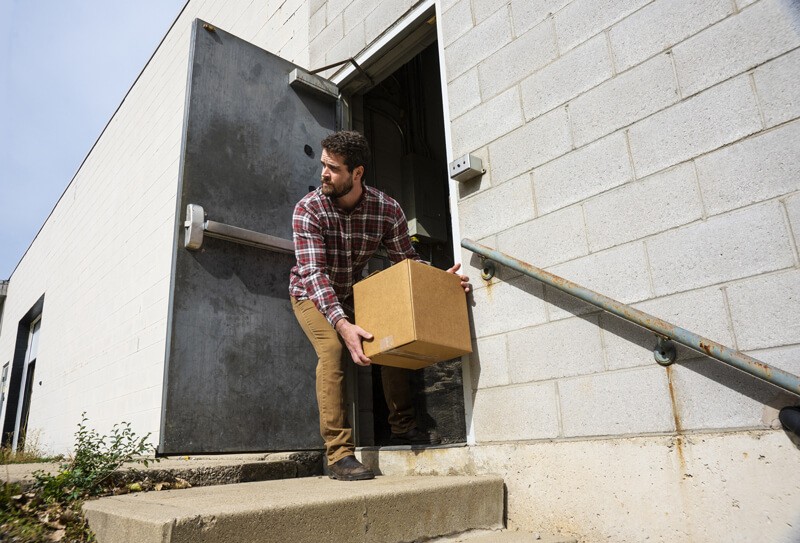
Instead of the tens to hundreds of dollars lost in the average point-of-sale employee theft incident, warehouses can experience thousand or even ten thousand dollar losses in a single internal theft incident.
Similarly, the large inventory can create a situation where it takes longer to find employee theft in a warehouse than in retail stores. If an employee is able to steal from a warehouse over months or years, the total loss can quickly exceed $100,000. In fact, a former Amazon employee was charged in July 2022 with stealing over $100,000 worth of merchandise. This same article mentions other thefts exceeding $10,000 as well.
Safety and Occupational Safety and Health Administration (OSHA)
Warehouses can be dangerous places. There are many places where OSHA violations may lead to serious injuries or worse:
- Careless forklift driving can lead to accidents with pedestrians.
- Poorly stacked inventory can topple over on an employee.
- Spilled liquids can result in slip-and-falls.
- Poorly stored dangerous chemicals can be used without required personal protective equipment (PPE).
These are just some of the common OSHA risks found in a warehouse. In fact, while many prospective clients come to Solink looking for help with internal and external theft issues, the ability to audit for OSHA regulation and company policy compliance can result in an even higher ROI. Improved operations is one of the core functions of the Solink platform.
Solink offers Blocked Exit Detection. With health and safety fines on the rise, Solink uses advanced AI to make sure your emergency doors remain clear. Now, when an employee inadvertently leaves boxes near the egress, you’ll receive an alert. This handy product can save organizations thousands of dollars per year.
Natural and human disasters
Natural disasters are sometimes unavoidable. However, proper training and procedures can mitigate the expected losses from these events. Better adherence to company policies can also reduce the likelihood that fires, floods, or other human-influenced disasters occur.
What are the components of a warehouse security camera system?
Warehouses face many safety and security risks, and therefore their security systems need to be particularly robust. Here are some of the major components of a warehouse security camera system.
Warehouse security cameras
Security cameras are the basis of the system. Most warehouses require some form of video security. However, if you stop at simply buying security cameras, then you are left with underutilized and incomplete infrastructure. To maximize the value of your warehouse security cameras, you’ll need the next three components at a minimum.
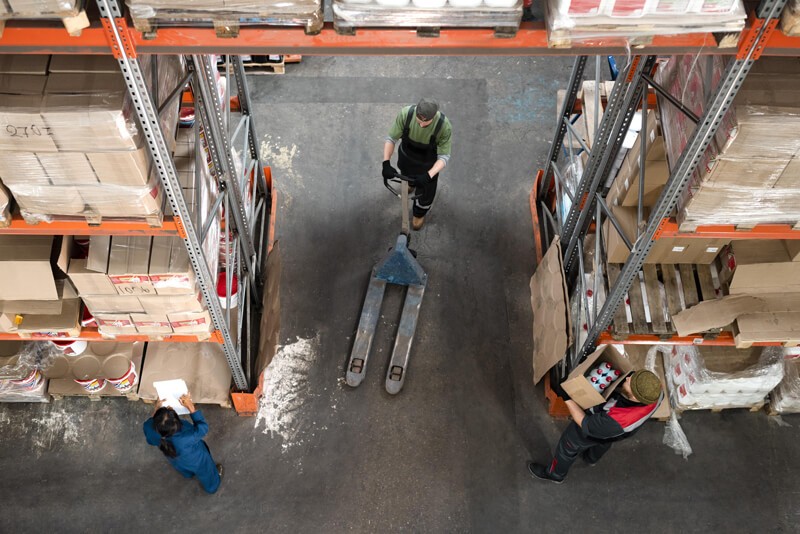
Data storage
Some cameras have data storage in them, but it is usually limited. Other cameras store directly to the cloud, which is great if you have the bandwidth and a good connection with zero downtime. Generally, you will need either a DVR (digital video recorder) or NVR (network video recorder) system to function as your data storage device. If you haven’t used one of these appliances before, take a look at our article comparing DVR vs. NVR.
These systems can be customized to meet the specific video retention needs of your business. Whether you need 15, 30, 90, or more days of onsite video storage, Solink can accommodate your warehouse security requirements with our hybrid cloud video storage system.
Internet
We live in a connected world, which means an Internet connection is always going to add functionality to your infrastructure. In the case of a warehouse security camera system, the Internet allows for remote backup, remote access to your cameras, and a lot of other benefits that greatly improve the efficiency of users.
For example, Solink automatically updates all of the software on our systems. In addition, Solink runs automated security camera health checks to tell you if your cameras have gone offline or are blocked in some way.
Video analytics platform
Video analytics is a critical part of a modern warehouse security camera system. Cameras are rich data sources that go well beyond the security domain. Collecting and storing but not putting into action that data can make every business decision harder.
Security cameras, data storage, the Internet, and cloud video security represent the core components of a warehouse security camera system. However, warehouse security goes beyond cameras and the tools that maximize their value.
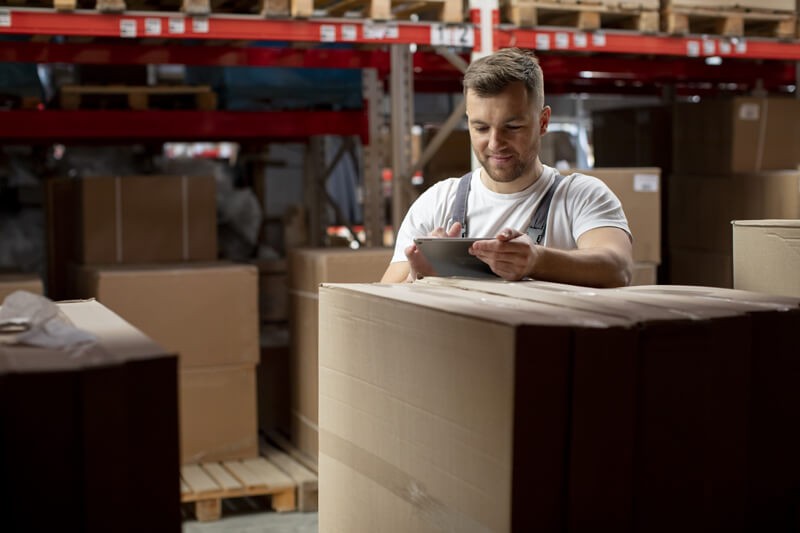
Next, we go into the other tools that are commonly found in a warehouse security system.
What other components should you consider for a warehouse security system?
Alarm systems
Many warehouses have alarm systems. Warehouse alarm systems can alert the owners of the system or the police when the system is triggered.
However, alarm systems have shortcomings that can lead to false alarm fines or miss true events, but video alarms can mitigate some of these issues. We discuss this in more detail below.
To see how Solink’s Video Alarms service can better protect your warehouse, sign up for a demo today.
Access control
Access control systems allow you to monitor who is entering and exiting your facility, or even different secure areas within your warehouse, and when. This is a fairly standard part of a warehouse security camera system.
However, there is a critical flaw in access control. Whether it is access code or fob based, there’s no guarantee that the person who entered your warehouse matches the user in the system. Password sharing or a stolen fob could lead to inaccurate access logs.
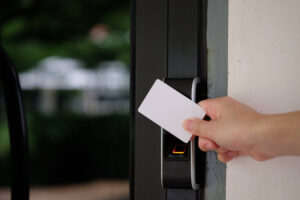
Solink can connect your warehouse video security system with access control data to match video footage of every access. That way, if something goes wrong, you have easy to access video verification of who entered your property.
Inventory tracking system/inventory management system
There are many different inventory tracking/management systems out there. Being able to keep track of your inventory digitally, and taking the time to audit the accuracy of your data, makes it less likely that internal theft will occur and more likely you’ll recover lost assets if it does.
Security cages
Security cages are essentially a security perimeter within your security perimeter. You can further lock down dangerous or expensive assets within a locked cage. Then, the separate access control system at the door of the security cage means fewer people have access to these specific items.
Security doors and windows
Strong doors with high-quality physical locks are an important part of a warehouse security system. The same goes for windows.
As the saying goes, “you are only as strong as your weakest link.” If you have doors or windows that can be easily broken through, then no access control will be able to prevent entrance into your warehouse.

Lighting
Lighting is another low-tech way to improve the security of your warehouse. Especially if you are utilizing outdoor security cameras 24/7, proper lighting will vastly improve the quality of your video footage.
Security guards
Many warehouses have on-site security guards. They can provide the ultimate deterrence to many criminal behaviors, including unlawful entrance into a facility. However, security guards can be expensive. This is even more true for large facilities where there might be a guard at the gate to the parking lot, a second at the main entrance to the building, and another guard patrolling the premises, with 24/7 on duty shifts.
This leads to the budgetary question of whether security guards can be replaced by a modern warehouse security camera system.
On-site security guards vs. warehouse video security system
The answer to whether warehouses can completely or only partially replace their on-site security guards with a warehouse video security system will need to be answered individually by each property manager.
However, what is evident is that video analytics is able to perform many of the same functions as a security guard at a lower cost, more efficiently, and faster.
For example, Camera Linking can enable the security guard at the entranceway to the facility to perform a virtual patrol of an entire facility in two minutes. That way one guard can perform the duties of two.
Why do you need a warehouse security camera system?
Warehouses have a lot of safety and security needs that necessitate an effective video security system. Here are some reasons a warehouse needs a security camera system.
Reduce inventory shrinkage
Warehouses carry more inventory than retail stores, and therefore reducing inventory shrinkage is particularly important. Both internal and external theft occur throughout the supply chain, and as mentioned above cargo theft is especially prevalent in warehouses.
Eliminating a single average $254,800 cargo theft event will pay for much more than a lifetime of enhanced security for your warehouse.
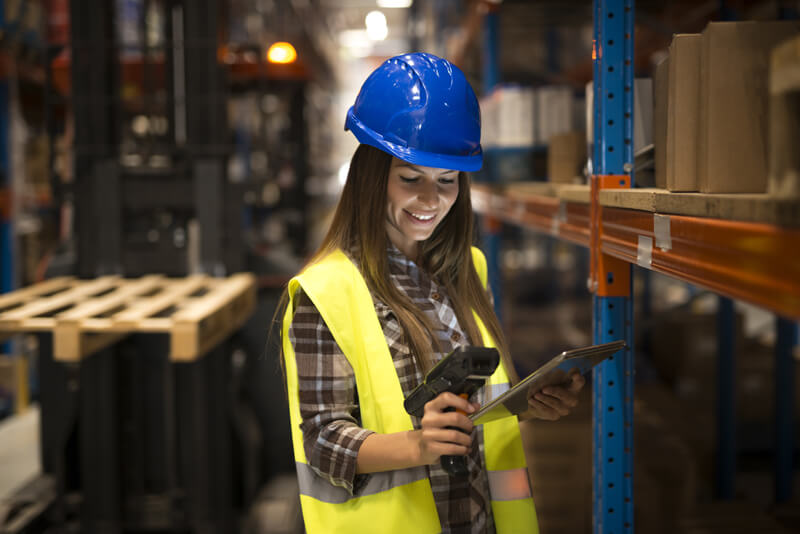
Enhance safety
A well-connected and monitored warehouse security camera system will improve the safety of your facility. By monitoring company and regulatory compliance, you can make sure emergency exits are clear, forklift drivers are obeying the internal traffic signage, and dangerous equipment and chemicals are used correctly and always safely stored when not being used.

Remote video monitoring
Remote video monitoring offers significant added value to a warehouse security camera system, so we have an entire other article dedicated to the topic. Being able to monitor all of your locations from the corporate head office, or even your home, means better control on the day-to-day operations of all your sites. You can also set up proactive alerts to be notified of specific events occurring within your facilities.
Optimize operations
Efficiency is a top priority at many warehouses. Reducing the time it takes to get each order out the door can have a major impact on the bottom line. A well-designed warehouse security camera system can help every part of your operations management.
Receive alerts and alarm verification
The Solink Video Alarms system means you will get alerts when motion is detected outside of normal business hours, or when motion is detected where there shouldn’t be motion. Then, you have the ability to see what is happening in real time before deciding to dispatch emergency services. Video alarm verification reduces the risk of costly false alarm fines.

Video alarms are just the first way to receive notifications from your warehouse security camera system. Connecting other systems such as access control to your video security system means Solink can notify you when your core metrics reach preset values.
Document events
Solink allows you to save and share video footage of events. If you find an employee stealing or an OSHA violation, simply save video evidence of the event. Solink bridges the gap between two crucial systems, video management system (VMS) and case management system (CMS), to improve the outcomes of internal investigations.
Upgrade your access control system
As mentioned above, access control systems are an important part of warehouse security. However, there is always the risk that a fob is stolen or employees share codes. Integrating access control with video security improves the security of your warehouse.
Enhance your emergency response
Solink gives companies the ability to share live footage of what is happening in their buildings with emergency dispatchers. Whether it’s an industrial accident, active shooter, or break and enter, emergency responders know exactly what is happening and can react more appropriately.
Here’s an example of how video alarms and traditional alarms differ:
- Traditional alarms: An alarm is sounded. Emergency response is requested, which may or may not be actioned. If responders arrive at a false alarm event, it can result in hefty fines.
- Video alarms: An alarm is triggered. The owners of the alarm system and/or trained professionals receive video footage of the event. If it is a false alarm, they cancel the alarm which means no potential for false alarm fines. If the alarm is a verified event, they share the real-time video footage with emergency dispatchers. The emergency response isn’t just to “event at X Warehouse” but rather to “active break and enter; three armed suspects; currently in the northwest quadrant of the building; arrived in a white truck license plate XXX-XXX.” That leads to better, faster resolutions.
Reduce insurance premiums
OSHA fines are expensive, but the flip side of that is also costly. If your warehouse has a history of safety incidents, then your insurance premiums are likely going to be higher than they need to be. Using your warehouse security camera system to audit health and safety regulation compliance can make your facility safer. That makes it a better place to work, as well as a cheaper place to insure.
What are the main types of warehouse security cameras?
There are many different types of warehouse security cameras. That’s one reason why Solink takes a technology agnostic approach to development.
That means that Solink is compatible with most security cameras on the market. Here’s a list of cameras compatible with Solink today.
CCTV cameras vs. analog cameras vs. IP cameras
These are three terms that will come up a lot when looking into security cameras for warehouses.
First, closed-circuit television (CCTV) is simply the opposite of broadcast TV. Whereas broadcast is aimed at sending video to many subscribers, CCTV transmits video to a small number of places. CCTV is sometimes synonymously used with video security for this reason. CCTV cameras are essentially security cameras, but just an older terminology.
Second, analog cameras transmit data over coaxial cables and are becoming obsolete. While currently installed analog cameras can still be used until they stop working, including in the Solink platform, it is recommended that you switch to IP cameras for future purchases.
Third, Internet protocol cameras (IP cameras) are controlled using an IP network and transmit data digitally. These are the modern replacements for analog cameras.
We provide a more in-depth look at different types of business security cameras in another article. For now, let’s look at a few of the types of security cameras you might encounter in a warehouse.
Bullet cameras
Bullet cameras are some of the most common warehouse security cameras on the market. They are small and get their name from their shape.
Their small size and easy installation make them particularly versatile. You can find them indoors and outdoors, and they are usually less noticeable than larger security cameras (e.g., the turret security cameras discussed next). However, their shape makes them less robust to vandalism than dome cameras (see below).
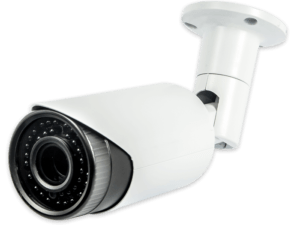
Turret cameras
Turret security cameras have a ball-and-socket design. Within the “turret”, the ball-like camera can be positioned to look at different angles. This makes their installation and re-positioning flexible. However, once installed, you’ll need to physically reposition the camera to get a new field of view.
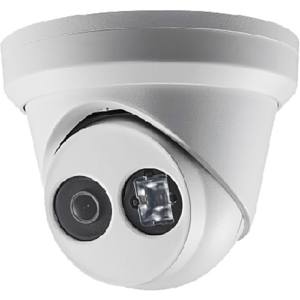
Dome cameras
Dome cameras are cameras covered with a dome. This obscures the direction they are facing, which can make employees and criminals less sure what is or is not in the camera’s field of view. Their shape and the dome protection make them more resistant to vandalism.
However, as with many of the other cameras on this list, it has a fixed viewing angle that cannot be changed remotely.

360 degree cameras (fisheye cameras)
Dome cameras are cameras covered with a dome. This obscures the direction they are facing, which can make employees and criminals less sure what is or is not in the camera’s field of view. Their shape and the dome protection make them more resistant to vandalism.
However, as with many of the other cameras on this list, it has a fixed viewing angle that cannot be changed remotely.
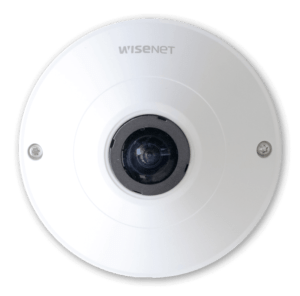
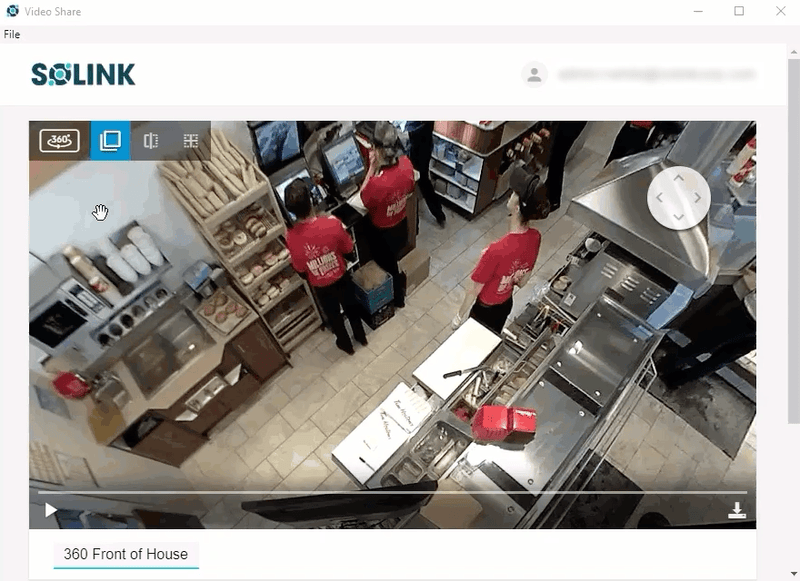
360 degree cameras show and record in every direction all the time. We’ve found that a single 360 degree security camera can replace four to six traditional security cameras in wide open areas.
What should you consider when choosing a warehouse security camera?
The following are some of the main features to consider when choosing your warehouse security cameras:
- Resolution: The resolution of a camera indicates how much detail will be recorded. A higher resolution will provide more details when reviewing the camera footage later.
- Frame rate: The frame rate is the number of frames per second that your camera records. Having a low frame rate (e.g., 5) will severely diminish your ability to track people across your facilities. Traditionally, security systems record at 10 frames per second, as it is a good balance between lower storage needs and good quality.
- Camera type: Different cameras are best suited for different environments. A bullet or turret camera can record a smaller area than a 360 degree security camera. So the former is best used to monitor a hallway or entrance, while the latter is better suited for monitoring an open area.
- Indoor/outdoor: Generally speaking, all security cameras can work indoors, but not all security cameras are appropriate outdoors. If you need both indoor and outdoor video security, then you should make sure any cameras placed outdoors are able to function in your local climate.
- Lighting: Some cameras are designed to operate in the dark. If this is important for you, then consider buying cameras with IR capabilities.
- Audio: Not all business security cameras record audio. If this is something you might need, then be sure to choose cameras that also record audio.
Warehouse alarm system
Most warehouses have alarm systems. As mentioned above, traditional alarm systems have a few disadvantages that are particularly problematic for warehouses:
- Alarm systems are essentially intrusion detection systems. A specific door, window, or gate is protected by an alarm system so anyone entering a location by an unexpected egress is missed.
- Alarms are either armed or disarmed, meaning that you cannot lockdown unused areas while the rest of a facility is in use.
- False alarms can lead to massive fines, and they might even result in alarms being ignored in the future.
Solink’s Video Alarms is the ideal warehouse alarm system. With video alarms, all of these problems can be eliminated. Here are some advantages of video alarms for warehouses:
- Warehouses can protect areas instead of just operating as part of a security perimeter.
- Video alarms can be turned on and off easily in the Solink app. You can quickly arm a specific area, change areas on the fly, or set a schedule for nighttime alarm services.
- Alarm verification is possible with video alarms. Verified alarms means that alarm detections are not blindly sent to emergency services. Instead, when an alarm event is triggered, live video of what is happening is sent to the owner of the alarm and/or Solink’s trained dispatchers. Only when a confirmed threat is detected are emergency services dispatched.
To see how Solink’s Video Alarms can help your warehouse, sign up for a demo today.
Warehouse security FAQ
Here are some frequently asked questions about warehouse security camera systems.
Which security camera is best for the warehouse?
Warehouses have a variety of security cameras. Most warehouse operators invest in modern IP security cameras. These usually include dome cameras, bullet cameras, and 360 cameras, depending on the location that needs to be covered.
Are there cameras in warehouses?
Most, if not all, warehouses have security cameras.
How long do warehouse cameras keep footage?
Warehouse security camera retention is an important question to ask when building a logistics security system. Solink can retain video footage for any amount of time, from 30 days up based on the security requirements of the warehouse.
Why are CCTV cameras important for warehouses?
CCTV cameras are an important part of warehouse security systems. Once their potential is unlocked through video analytics, CCTV cameras can help with loss prevention, security, and operations. CCTV cameras can even replace a warehouse alarm system.
What kind of security can be provided in a warehouse?
Warehouses have different security needs, which dictate different security systems. Here are some of the common security features of warehouses.
- Warehouse security cameras
- Video analytics
- Proper lighting
- Video alarm systems
- Security patrols
- Access control systems
- Security cages for easy to steal items
- Inventory tracking
- Entryway security doors
- Window security
- Security guards
Why is safety and security important in the warehouse?
Warehouses can be dangerous places to work. Without careful planning and training, injuries can occur. Similarly, warehouses also have high-value inventory, and the right security planning and tools are necessary to protect company assets.
What are the most common risks in a warehouse?
Warehouses face many risks. Some of the common ones are:
- Employee safety
- External theft
- OSHA fines
- Break-ins
- Vandalism
- Internal theft
- Fires
How can risks be prevented in a warehouse?
Security, health and safety, and other risks can be reduced through vigilance. The correct tools, processes, and training work together to reduce risks in warehouses.
How do warehouses secure inventory?
Inventory management systems, access control, security cameras, and video analytics all work together to protect the inventory in warehouses.
How much does a warehouse security system cost?
The cost of a warehouse security system will depend on the level of security you require and the size of your facility. However, stopping one theft or preventing one industrial accident will often pay for a lifetime of enhanced security.
Solink is the best warehouse security camera system
Warehouse security systems are more than just cameras or access control. Solink’s video analytics solution connects all of your systems to improve security and unlock your data.
To find out how Solink gets the most out of your warehouse video security system, sign up for a demo today.
